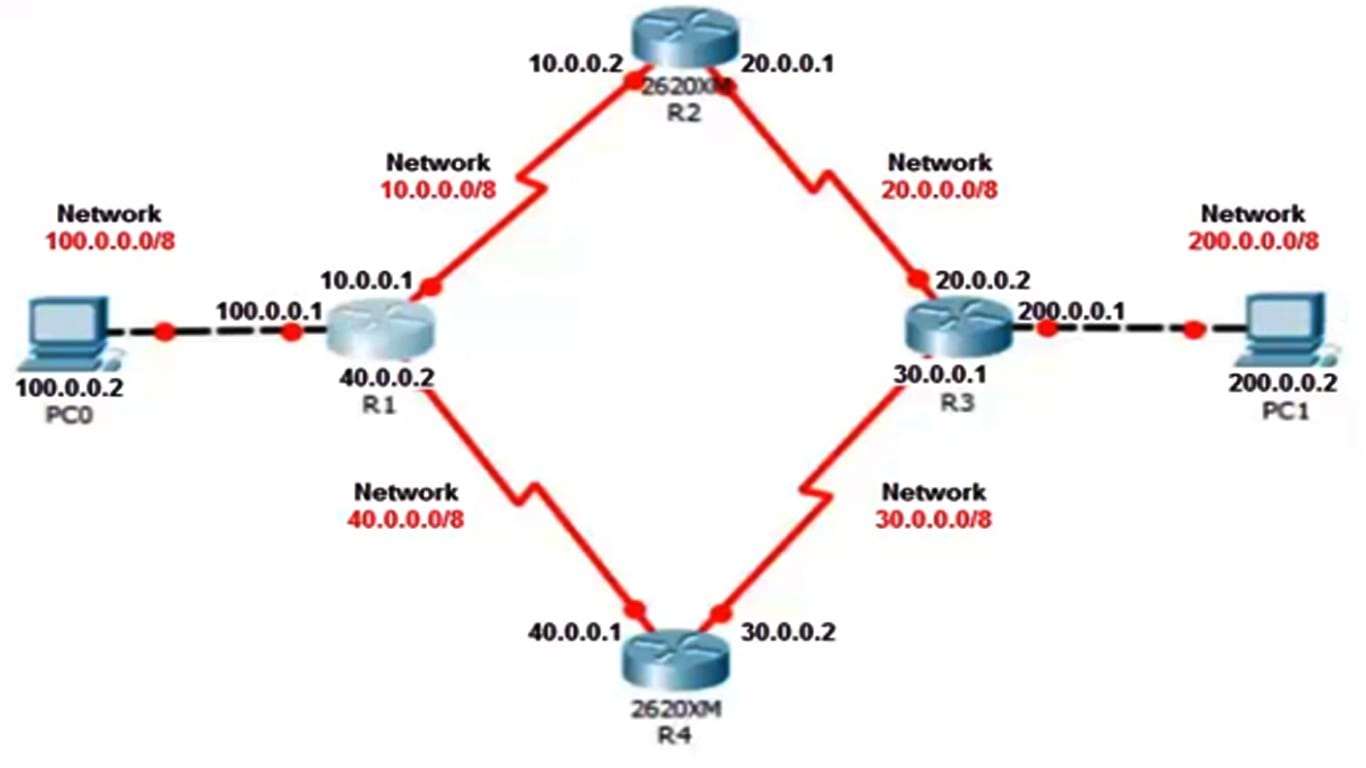EIGRP stands for Enhanced Interior Gateway Routing Protocol. It uses bandwidth and delay as their default metrics for choosing the best route to send packets. In this post, I am going to share with you, How to configure EIGRP in Packet Tracer and you will learn how to configure eigrp between four routers.
At the end of this post, I have shared with you the live video tutorial on this topic.

Step 1: Assign an IP Address to all the ports of the routers and PCs according to the diagram given above.
Router 1 IP Configuration
Router>
Router>en (Enable priviledge Mode)
Router#conf t (Enable Global Configuration Mode)
Router(config)#int s0/0 (Selecting first serial port s0/0)
Router(config-if)#ip add 10.0.0.1 255.0.0.0 (Adding IP Address)
Router(config-if)#clock rate 64000 (Adding Clock Rate)
Router(config-if)#bandwidth 72000 (Adding Bandwidth, Add higher bandwidth to the route to give high priority)
Router(config-if)#no shut (Enabling the port)
Router(config-if)#int s0/1 (Selecting second serial port s0/1)
Router(config-if)#ip add 40.0.0.2 255.0.0.0 (Adding IP Address)
Router(config-if)#no shut (Enabling the port)
Router(config-if)#int f0/0 (Selecting the fast ethernet port f0/0)
Router(config-if)#ip add 100.0.0.1 255.0.0.0 (Adding an IP Address)
Router(config-if)#no shut (Enabling the port)
Router(config-if)#exit
Router 2 IP Configuration
Router>
Router>en
Router#conf t
Router(config-if)#int s0/0
Router(config-if)#ip add 10.0.0.2 255.0.0.0
Router(config-if)#no shut
Router(config-if)#int s0/1
Router(config-if)#ip add 20.0.0.1 255.0.0.0
Router(config-if)#clock rate 64000
Router(config-if)#bandwidth 72000
Router(config-if)#no shut
Router(config-if)#exit
Router 3 IP Configuration
Router>
Router>en
Router#conf t
Router(config)#int s0/0
Router(config-if)#ip add 20.0.0.2 255.0.0.0
Router(config-if)#no shut
Router(config-if)#int s0/1
Router(config-if)#ip add 30.0.0.1 255.0.0.0
Router(config-if)#clock rate 64000
Router(config-if)#no shut
Router(config-if)#int f0/0
Router(config-if)#ip add 200.0.0.1 255.0.0.0
Router(config-if)#no shut
Router(config-if)#exit
Router 4 IP Configuration
Router>
Router>en
Router#conf t
Router(config)#int s0/0
Router(config-if)#ip add 30.0.0.2 255.0.0.0
Router(config-if)#no shut
Router(config-if)#int s0/1
Router(config-if)#ip add 40.0.0.1 255.0.0.0
Router(config-if)#clock rate 64000
Router(config-if)#no shut
So, guys, we have successfully added the IP Address on all the four routers.
Add IP Address to PC 1
IP: 100.0.0.2
Subnet Mask: 255.0.0.0
Gateway: 100.0.0.1
Add IP Address to PC 2
IP: 200.0.0.2
Subnet Mask: 255.0.0.0
Gateway: 200.0.0.1
Important Note:
We have added bandwidth only in the router 1 and the router 2 because we want this route to be the successor. While sending packets from PC 1 to PC 2, the router 1 will choose this route. (PC 1 -> R1 -> R2 -> R3 -> PC 2). Because it has the higher bandwidth.
If this route gets failed, then it will choose the alternate route. i.e. (PC 1 -> R1 -> R4 -> R3 -> PC 2)
How to configure EIGRP in Packet Tracer
Let’s, configure EIGRP between four routers
Configure EIGRP in Router 1
Router(config)#
Router(config)#router eigrp 10 (Enabling EIGRP Protocol and here 10 is the AS number which should be same on all the routers)
Router(config-router)#network 10.0.0.0 (Adding neighbour network 10.0.0.0)
Router(config-router)#network 40.0.0.0 (Adding neighbour network 40.0.0.0)
Router(config-router)#network 100.0.0.0 (Adding neighbour network 100.0.0.0)
Router(config-router)#^Z (Press Ctrl + Z to save the configuration)
Router#
So we have successfully configured EIGRP Protocol in the router number 1.
Important Note:
- Make sure, all the routers must have the same autonomous system (AS) number which you have assigned to the router 1. i.e. 10.
- In the router only add the neighbor networks to which your router is directly connected to. For example, in the Router 1, we have only added 10.0.0.0, 40.0.0.0 and 100.0.0.0 because this is the three networks to which the Router 1 is directly connected to.
- Now apply the same commands to configure the route using EIGRP Protocol on all the other three routers.
Configure EIGRP in Router 2
Router(config)#
Router(config)#router eigrp 10
Router(config-router)#network 10.0.0.0
Router(config-router)#network 20.0.0.0
Router(config-router)#^Z
Router#
Configure EIGRP in Router 3
Router(config)#
Router(config)#router eigrp 10
Router(config-router)#network 20.0.0.0
Router(config-router)#network 30.0.0.0
Router(config-router)#network 200.0.0.0
Router(config-router)#^Z
Router#
Configure EIGRP in Router 4
Router(config)#
Router(config)#router eigrp 10
Router(config-router)#network 30.0.0.0
Router(config-router)#network 40.0.0.0
Router(config-router)#^Z
Router#
List of important EIGRP Commands:
- show ip route: Displays all the route in the routing table
- show ip route eigrp: Only displays the best possible route to reach the destination according to EIGRP.
- show ip eigrp neighbors: Displays the neighbor IP Address with the uptime information.
- show ip eigrp topology: Displays how devices are connected in the network with successors and feasible distance.
So, guys, this is all about how to configure EIGRP between four routers in packet tracer. Hope, all the concept is clear. Anyhow, if you have any doubt, feel free to let me know in the comment section below, I will try to help you.


